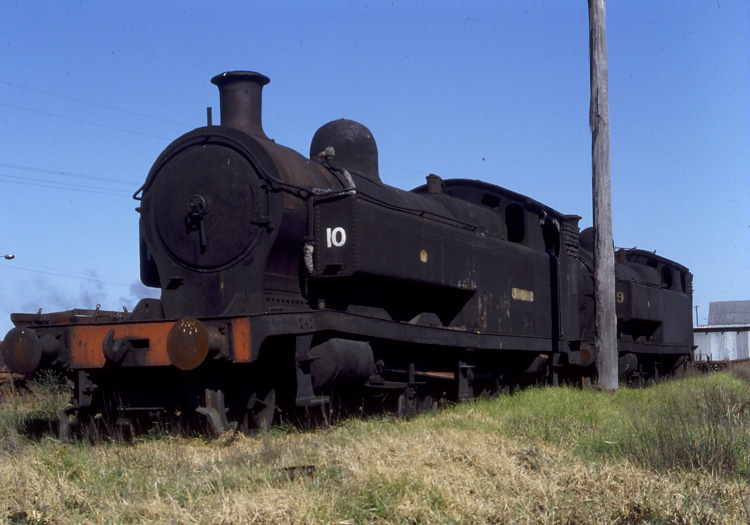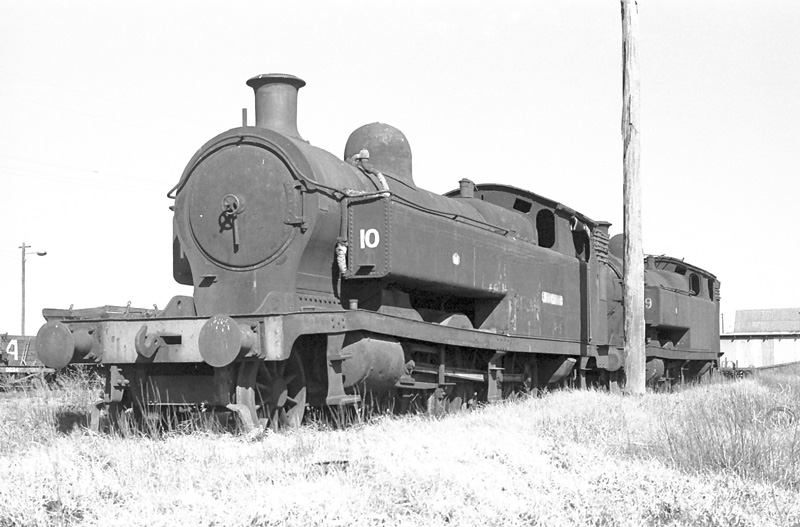|
|
J & A Brown No.9 Richmond Vale Railway Museum |
|

J & A Brown No.9 displayed with four 4-wheel coal
hoppers and a Brown’s brake van at the Richmond Vale Railway Museum on 16
February 2020.
Cosmetic repainting of the loco was underway at his time.
This view was kindly contributed by Nick Prinz.
|
Builder |
Kitson & Company Ltd,
Leeds |
|
||||||
|
Builder’s Number & Year |
4567 of 1908 |
|
||||||
|
Wheel Arrangement |
2-8-2T |
|
||||||
|
Since J
& A Brown’s four ex-Mersey Railway 0-6-4T locomotives had proven
disappointing on Richmond Vale Railway main line coal haulage, Kitson & Co
of Leeds were engaged to design and build a suitable heavy tank locomotive
for this work. The product was a chunky 2-8-2T locomotive, based on their
earlier 0-8-0 tender design which Kitson had built for the Great Central
Railway as their class 8A. Presumably Kitson were able to re-use many of
the class 8A drawings, patterns and tooling; indeed, this handsome tank loco
looked like it belonged on the Great Central Railway rather than an
antipodean colliery line! The locomotive became J & A Brown No.9 and
proved successful over the grades and tunnels of the Richmond Vale Railway as
it crossed the Sugarloaf Range. Two further locos Nos.10 & 11 followed in
1911, with the trio receiving handsome brass nameplates ‘Pelaw Main’,
‘Richmond Main’ and ‘Hexham’ after the line’s principle running sheds:
The Great
Central Railway family likeness within J & A Brown’s loco fleet was
reinforced after World War 1 with the arrival of thirteen 2-8-0 locomotives
purchased as war surplus from the British Army’s Railway Operating Division
(ROD). The ROD had built 521 such locomotives to the Great Central Railway’s
class 8K design, itself a development of the 0-8-0 class 8A design upon which
J & A Brown’s 2-8-2T locos were based. Interestingly, the Great Central
Railway’s first class 8K 2-8-0 loco was completed in 1911 and so it can be
imagined that famous design may have been influenced by J & A Brown’s
earlier 2-8-2T. In any case, the J & A Brown loco stud certainly
displayed a strong Great Central Railway influence, and the tender and tank
locomotive types apparently benefitted from interchangeability of many parts. The three
2-8-2T locos originally wore dark green livery and were shedded at Pelaw Main
for coal haulage through the Sugarloaf Range and across Hexham swamp to the
NSWGR exchange sidings and coal staiths on the Hunter River at Hexham. They
were largely displaced from main line running by the ROD 2-8-0’s, while the
2-8-2T locos were better suited to shunting the long lines of 4-wheel hopper
wagons and cutting out any cripples. Photos show the 2-8-2T locos also hauled
the J & A Brown miners’ trains (comprising a ramshackle collection of
4-wheel passenger carriages) over the ‘link line’ between Pelaw Main and
Richmond Main collieries – which now forms the running line of today’s
Richmond Vale Railway Museum. All three
Kitson 2-8-2T locos found somewhat sporadic use later in their working lives,
including periods of storage or hire to nearby colliery lines. No.11 proved
to be the unlucky one, last working in 1950 and scrapped in September 1966
together with other retired J & A Brown locos stored in the ‘Fodder Shed’
at Wallis Creek, apparently to harvest the loco springs as spares. Following
the closure of Pelaw Main and Richmond Main collieries in the 1960’s, the
railway across the Sugarloaf Range was truncated to the shorter trip across
Hexham Swamp to Stockrington Colliery in the foothills. The remaining ROD
2-8-0 engines joined the eclectic mix of steam locos dumped near the Hexham
loco shed, while No.9 and No.10 were returned to service to handle remaining
traffic including sorting the huge fleet of 4-wheel hoppers at Hexham and the
nearby coal washery. The
webmaster has fond memories of No.9 & No.10 and the railway operations at
Hexham because family holidays involved driving past on the way to the
mid-north coast. Being approximately half-way on our journey – and my father
having an interest in steam locos - a stop at Hexham was always part of the
trip! We would first enjoy an ‘OAK’ milk shake, followed by a detour over the
NSWGR railway crossing to the extensive nests of Richmond Vale Railway
sidings. As circumstances permitted (including less patient family members)
we would try to get to the steam loco running sheds! Early 1970’s visits were
greeted by lines of rust-streaked ROD 2-8-0’s, which had tragically
disappeared by Christmas 1973 - to the heartbreak of this young enthusiast -
while the two Kitson 2-8-2Ts could still be found shunting the washery or
returning from Stockrington Colliery. Four ex-South Maitland Railways 2-8-2T
locos later joined the running shed at Hexham, with the older loco No.9 being
the last of the two Kitson tank engines active when retired in 1980. Rather
ominously they were then stored outside the running shed in much the same
position as the ROD 2-8-0’s which met their fate in 1973. By the 1980’s I
also recall the hundreds of wooden coal hoppers were progressively being
burned – several at a time - for scrap metal at a site near the wash plant,
with the remaining iron and steel recovered from the ashes. Alas the
remaining portion of the Richmond Vale Railway closed in September 1987 after
consultants devised a ham-fisted strategy to replace rail haulage at
Stockrington Colliery with road transport, resulting in a worker’s strike and
blockade at the loading bins. Road haulage apparently was not sufficient to
maintain financial viability and Stockrington Colliery closed in 1988,
marking the end of a fascinating relic of living industrial heritage. Today
there is little trace of Stockrington Colliery and its loading sidings; while
the rails remain in situ from the colliery across Hexham Swamp, unfortunately
the route was severed when the Pacific Freeway was extended across the
trackbed. The Hexham Swamp itself has been a focus of restoring the natural
environment, which had been damaged by flood defences and drainage schemes
which starved the swamp of the necessary water inflows. On a more positive
note, a portion of the Richmond Vale Railway route through the Sugarloaf
Range has now been reopened as a cycling track. Fortunately,
both No.9 & No.10 were preserved, moving by road to the formative
Richmond Vale Railway Museum on 19 June 1982. (I first became aware of the
Richmond Vale Railway Museum following another family holiday to the
mid-North Coast, but where the two tank locomotives were not present outside
the Hexham running shed! Concerned that they might have gone the way of the
ROD 2-8-0’s, I made enquiries which led to the happy news they had moved to
Richmond Main Colliery, where a museum and operating railway was being established.
I next saw the two locos at my first visit to Richmond Vale Railway Museum in
1984 on a learn-to-drive day trip under the instruction of my father.) During an
early visit to the Richmond Vale Railway Museum (RVRM) a volunteer discussed
consideration of returning one of the Kitson tank locos to steam at reduced
boiler pressure, as full pressure was not needed for a light passenger train.
Alas such a reactivation has never occurred; in practice I imagine both tank
locos require extensive boiler renewal and mechanical work before they could
be steamed, together with the thorough inspection and documentation of all
parts that is required by modern safety regulations and insurance provisions.
Instead, the two locos remained in open display within the colliery sidings,
receiving at least one cosmetic repaint around this period. Alas the RVRM
lacks a suitable covered display building for their large railway exhibits
and the elements have taken their toll on Nos. 9 & 10, and the two were
shunted away from public view by 2000 – possibly also due to concerns about
boiler insulation, or the locos being unsafe for children to climb on.
Fortunately, their impressive brass nameplates and builder’s plates are held
in safekeeping and are displayed among the small exhibits. During
2020 cosmetic repainting of No.9 was begun, and this work was completed by
July 2021 (as evidenced in a photograph below) while No.10 remains in storage
away from visitors. Hopefully funding can one day be found for a suitable
display building for the RVRM’s large exhibits such as these locomotives. Several
excellent books have been written about the railways and locomotives of J
& A Brown and the South Maitland Coalfields, whose rich variety of
locomotives and operations make for compelling reading for
ferroequinologists. Perhaps the most comprehensive source of information for
No.9 and her stablemates is the well-illustrated work ‘Coal, Railways &
Mines – The Story of the Railways and Collieries of J & A Brown’ by Brian
Robert Andrews, published by the Iron Horse Press, 2004. |
|||||||||

This fascinating information sheet from Kitson & Co
promotes their capabilities – it seems they were proud of J & A Brown No.9!
Source: Flickr – Historical Railway
Images - Kitson Steam Locomotives Catalogue 1839-1923
https://www.flickr.com/photos/124446949@N06/49897832032/in/photostream/

J & A Brown tank locos No.9 & No.10 out to pasture near
the Hexham loco shed, circa 1982.
Gaps in the paintwork clearly show where
the name and builder’s plates had recently been removed, but fortunately these
were saved for display.
Drifting black smoke in the background
reveals the presence of one of the SMR 10-class tank locos drafted in as
replacements.
This photo was kindly contributed by Anthony Winstone.

Much the same scene as the colour view above, but in Black
& White – I love the comparison between the two formats.
Both locos display a distinct deformation
in the running plates in front of the cylinders – possibly due to lifting, or
evidence of many years of heavy shunting.
This photo was kindly contributed by Anthony Winstone.

A scanned print image of J & A Brown No.9 stored
(largely away from public view) at Richmond Main on 27 April 2002.

This second photo contributed by Nick Prinz shows No.9 with
cosmetic restoration & repainting underway on 16 February 2020.
Some of the rust is superficial, but the metal moth has
eaten through the bunker platework.

This view of July 2021 shows No.9 fresh from cosmetic
restoration, together with four newly repainted RVR coal hoppers and the
Brown’s brake van.
A sponsor’s sign is coyly placed to hide
the rust hole in the bunker platework!
My thanks to Jacob Van Groningen for contributing this
photograph.
References
|
a |
Preston, R.
G. ‘The Richmond Vale Railway’ published
by the New South Wales Rail Transport Museum, 1989. |
|
b |
Oberg, L.
‘Locomotives of Australia - 1985 to 2010’ (Fifth Edition), published
2010 by Rosenberg Publishing Pty Ltd |
|
c |
Andrews, B. R. ‘Coal, Railways & Mines – The
story of the Railways and Collieries of J & A Brown’, published
by the Iron Horse Press, 2004. |
Page updated: 22 August 2021
|
Government Railways: |
|
|||||||||
|
Private & Industrial Railways: |
|